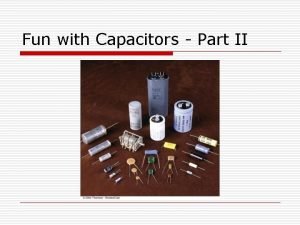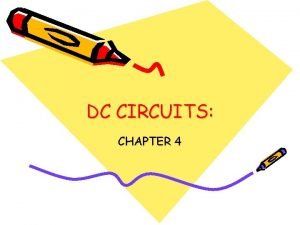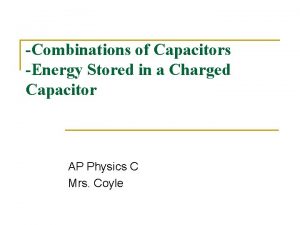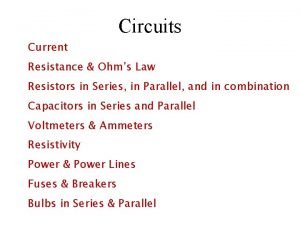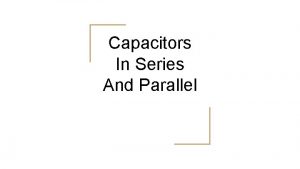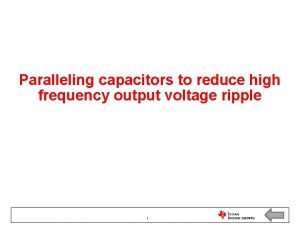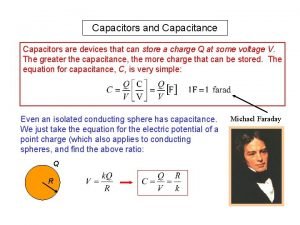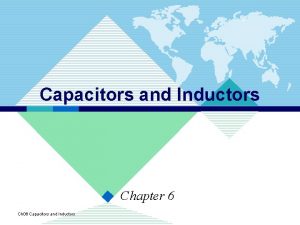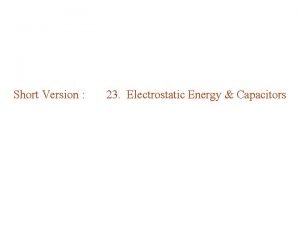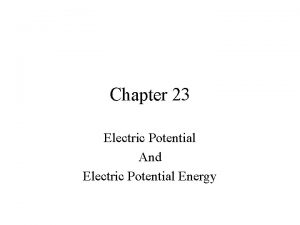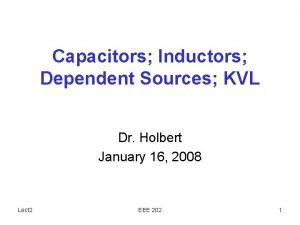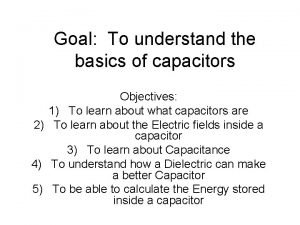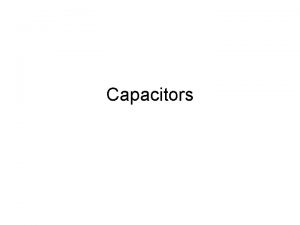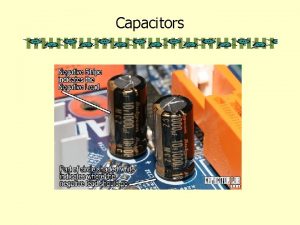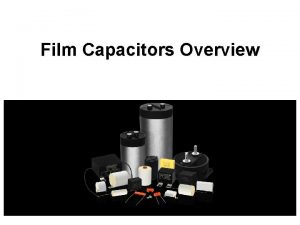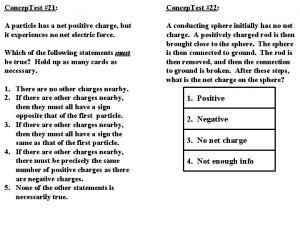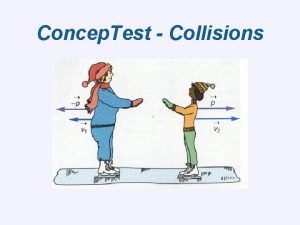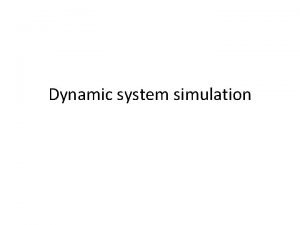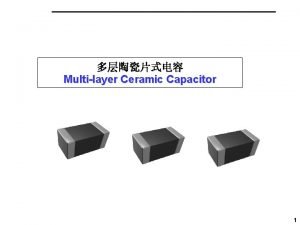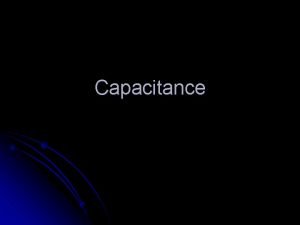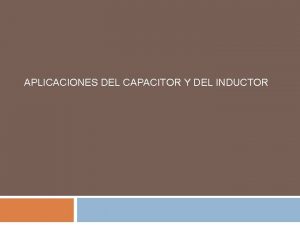Concep Test 25 1 Capacitors Capacitor C 1














- Slides: 14

Concep. Test 25. 1 Capacitors Capacitor C 1 is connected across 1) C 1 a battery of 5 V. An identical 2) C 2 capacitor C 2 is connected across a battery of 10 V. Which one has the most charge? +Q –Q 3) both have the same charge 4) it depends on other factors

Concep. Test 25. 1 Capacitors Capacitor C 1 is connected across 1) C 1 a battery of 5 V. An identical 2) C 2 capacitor C 2 is connected across a battery of 10 V. Which one has the most charge? 3) both have the same charge 4) it depends on other factors +Q –Q Since Q = C V and the two capacitors are identical, the one that is connected to the greater voltage has the most charge, charge which is C 2 in this case.

Concep. Test 25. 2 a Varying Capacitance I What must be done to a 1) increase the area of the plates capacitor in order to 2) decrease separation between the plates increase the amount of 3) decrease the area of the plates charge it can hold (for 4) either (1) or (2) a constant voltage)? 5) either (2) or (3) +Q –Q

Concep. Test 25. 2 a Varying Capacitance I What must be done to a 1) increase the area of the plates capacitor in order to 2) decrease separation between the plates increase the amount of 3) decrease the area of the plates charge it can hold (for 4) either (1) or (2) a constant voltage)? 5) either (2) or (3) +Q –Q Since Q = C V, V in order to increase the charge that a capacitor can hold at constant voltage, one has to increase its capacitance Since the capacitance is given by , that can be done by either increasing A or decreasing d.

Concep. Test 25. 2 b Varying Capacitance II A parallel-plate capacitor 1) the voltage decreases initially has a voltage of 400 V 2) the voltage increases and stays connected to the 3) the charge decreases battery. If the plate spacing is now doubled, what happens? 4) the charge increases 5) both voltage and charge change +Q –Q

Concep. Test 25. 2 b Varying Capacitance II A parallel-plate capacitor 1) the voltage decreases initially has a voltage of 400 V 2) the voltage increases and stays connected to the 3) the charge decreases battery. If the plate spacing is now doubled, what happens? 4) the charge increases 5) both voltage and charge change Since the battery stays connected, the voltage must remain constant ! Since when the spacing d is doubled, the capacitance C is halved. And since Q = C V, V that means the charge must decrease Follow-up: How do you increase the charge? +Q –Q

Concep. Test 25. 2 c Varying Capacitance III A parallel-plate capacitor initially has a potential difference of 400 V and is then disconnected from the charging battery. If the plate spacing is now doubled (without changing Q), what is the new value of the voltage? +Q –Q 1) 100 V 2) 200 V 3) 400 V 4) 800 V 5) 1600 V

Concep. Test 25. 2 c Varying Capacitance III A parallel-plate capacitor initially has a potential difference of 400 V and is then disconnected from the charging battery. If the plate spacing is now doubled (without changing Q), what is the new value of the voltage? Once the battery is disconnected, Q has to remain constant, constant since no charge can flow either to or from the battery. Since when the spacing d is doubled, the capacitance C is halved. And since Q = C V, V that means the voltage must double 1) 100 V 2) 200 V 3) 400 V 4) 800 V 5) 1600 V +Q –Q

Concep. Test 25. 3 a Capacitors I 1) Ceq = 3/2 C What is the equivalent capacitance, 2) Ceq = 2/3 C Ceq , of the combination below? 3) Ceq = 3 C 4) Ceq = 1/3 C 5) Ceq = 1/2 C o Ceq o C C C

Concep. Test 25. 3 a Capacitors I 1) Ceq = 3/2 C What is the equivalent capacitance, 2) Ceq = 2/3 C Ceq , of the combination below? 3) Ceq = 3 C 4) Ceq = 1/3 C 5) Ceq = 1/2 C The 2 equal capacitors in series add o up as inverses, inverses giving 1/2 C. These are parallel to the first one, which add up directly Thus, the total equivalent capacitance is 3/2 C. Ceq o C C C

Concep. Test 25. 3 b Capacitors II How does the voltage V 1 across 1) V 1 = V 2 the first capacitor (C 1) compare 2) V 1 > V 2 to the voltage V 2 across the 3) V 1 < V 2 second capacitor (C 2)? 4) all voltages are zero C 2 = 1. 0 m. F 10 V C 1 = 1. 0 m. F C 3 = 1. 0 m. F

Concep. Test 25. 3 b Capacitors II How does the voltage V 1 across 1) V 1 = V 2 the first capacitor (C 1) compare 2) V 1 > V 2 to the voltage V 2 across the 3) V 1 < V 2 second capacitor (C 2)? 4) all voltages are zero The voltage across C 1 is 10 V. The combined capacitors C 2+C 3 are parallel to C 1. The voltage across C 2+C 3 is also 10 V. Since C 2 and C 3 are in series, their voltages add. Thus the voltage across C 2 and C 3 each has to be 5 V, which is less than V 1. C 2 = 1. 0 m. F 10 V C 1 = 1. 0 m. F C 3 = 1. 0 m. F Follow-up: What is the current in this circuit?

Concep. Test 25. 3 c How does the charge Q 1 on the first capacitor (C 1) compare to the charge Q 2 on the second capacitor (C 2)? Capacitors III 1) Q 1 = Q 2 2) Q 1 > Q 2 3) Q 1 < Q 2 4) all charges are zero C 2 = 1. 0 m. F 10 V C 1 = 1. 0 m. F C 3 = 1. 0 m. F

Concep. Test 25. 3 c How does the charge Q 1 on the first capacitor (C 1) compare to the charge Q 2 on the second capacitor (C 2)? Capacitors III 1) Q 1 = Q 2 2) Q 1 > Q 2 3) Q 1 < Q 2 4) all charges are zero We already know that the C 2 = 1. 0 m. F voltage across C 1 is 10 V and the voltage across C 2 and C 3 each is 5 V. Since Q = CV and C is the same for all the capacitors, then since V 1 > V 2 therefore Q 1 > Q 2. 10 V C 1 = 1. 0 m. F C 3 = 1. 0 m. F
 Concept map tungkol sa pamilihan
Concept map tungkol sa pamilihan Fun with capacitors
Fun with capacitors Introduction of capacitor and inductor
Introduction of capacitor and inductor Voltage across capacitors in series
Voltage across capacitors in series Resistor in series and parallel
Resistor in series and parallel Capacitors in series examples
Capacitors in series examples Paralleling capacitors
Paralleling capacitors Equation for capacitance of a capacitor
Equation for capacitance of a capacitor I = c dv/dt example
I = c dv/dt example Electrostatic energy density
Electrostatic energy density Energy stored in capacitors
Energy stored in capacitors Kvl capacitor
Kvl capacitor Capacitor energy
Capacitor energy Flat ppr
Flat ppr The basics of capacitors
The basics of capacitors

